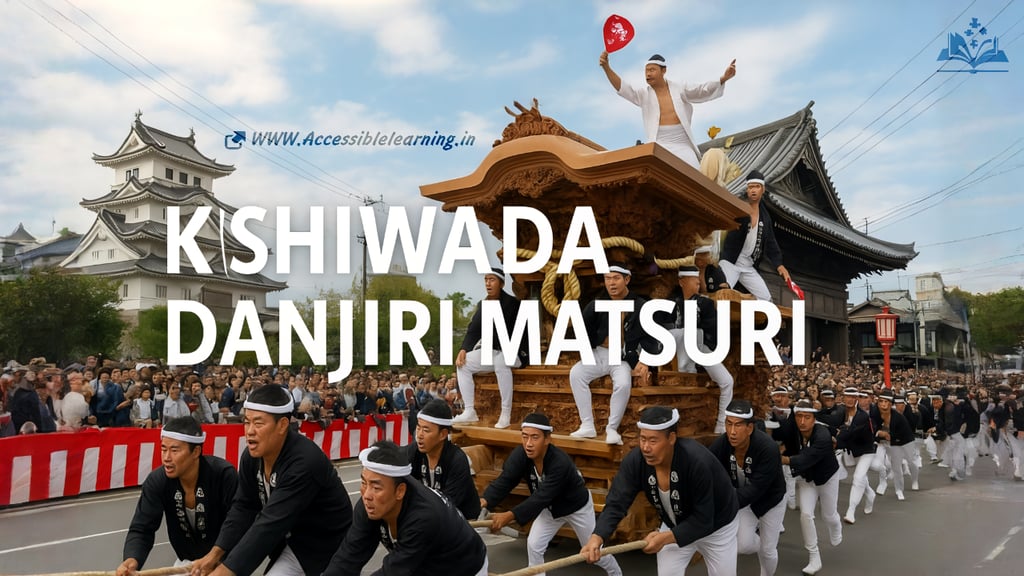
Kishiwada Danjiri Matsuri: Japan’s Most Thrilling Float Festival
Discover the thrilling Kishiwada Danjiri Matsuri in Osaka, Japan’s most exciting traditional festival. Learn its history, rituals, high-speed danjiri float races, cultural significance, and visitor tips for experiencing this centuries-old celebration of courage and unity.
CULTURE/TRADITIONEVENT/SPECIALTRAVEL LIFECELEBRATION/FESTIVALSJAPAN
Kim Shin
9/10/20253 min read


In the heart of Osaka Prefecture, the Kishiwada Danjiri Matsuri (岸和田だんじり祭り) stands as one of Japan’s most electrifying and adrenaline-fueled traditional festivals. Known for its high-speed wooden floats, roaring chants, and the overwhelming sense of unity, this centuries-old event is not just a cultural performance but a living spirit of community, bravery, and tradition.
Every year, hundreds of thousands of visitors gather in Kishiwada City to witness the spectacular sight of giant wooden danjiri floats racing through narrow streets—pulled by teams of men with extraordinary skill, energy, and devotion.
Let’s dive deep into the origins, traditions, rituals, and unique charm of the Kishiwada Danjiri Matsuri.
Historical Origins of Kishiwada Danjiri Matsuri
The Kishiwada Danjiri Festival traces its roots back to 1703, during the Edo period. It was initiated by Okabe Nagayasu, the feudal lord of Kishiwada Castle, who prayed for a rich harvest and prosperity. Inspired by Kyoto’s famous Gion Festival, he introduced danjiri floats—lavishly decorated wooden carts that served as mobile shrines to Shinto deities.
Initially, the festival was more ceremonial and religious. Over time, however, the competitive and dynamic pulling of danjiri became its defining feature, symbolizing strength, teamwork, and devotion to the gods.
What is a Danjiri?
A danjiri is a massive, hand-carved wooden float, often weighing several tons. These floats are
Crafted from wood by master artisans and decorated with intricate carvings of mythological figures, dragons, and lions.
Equipped with wheels, ropes, and sometimes drums and flutes.
Representing a local neighborhood or community, with each team responsible for its danjiri’s maintenance and performance.
The danjiri is more than a float—it’s a sacred vessel that carries the spirit of the gods during the festival.
The Festival Highlights
The Kishiwada Danjiri Matsuri is not just about pulling floats—it’s about speed, precision, and risk-taking.
1. Yarimawashi (High-Speed Cornering)
The most breathtaking moment is the yarimawashi, when the float makes a sharp 90-degree turn at full speed. Dozens of men pull the float with thick ropes, while others push from behind, and a brave leader, called the daiku-gata (carpenter leader), stands atop the danjiri, guiding the team with dramatic movements.
The crowd cheers as the float tilts dangerously, testing both balance and teamwork.
The maneuver is risky—accidents are not uncommon, but it adds to the thrill.
2. Chants and Music
Each team chants “Sorya! Sorya!” while pulling, accompanied by flutes, taiko drums, and bells. The sound resonates across the city, fueling energy and unity.
3. Night Danjiri (Yoiyama)
At night, the danjiri are illuminated with lanterns, creating a more ceremonial and mystical atmosphere. Unlike the high-speed day races, the nighttime procession is slower and elegant, symbolizing reverence to the gods.
Dates and Location
The main Kishiwada Danjiri Festival is held every year in September (around the weekend before Respect for the Aged Day).
Location: Kishiwada City, Osaka Prefecture, Japan.
Duration: 2 days of high-energy pulling and night parades.
There is also a less intense version of the festival in October, celebrated in different parts of the city.
Cultural Significance
The Kishiwada Danjiri Matsuri is more than just entertainment—it carries deep cultural value:
Shinto Belief: Offering prayers for a rich harvest and community safety.
Community Bonding: Each neighborhood participates with pride, showing unity across generations.
Heritage Preservation: The craft of danjiri-making, music, and rituals are passed down through families.
Symbol of Courage: The festival highlights Japanese values of bravery, discipline, and teamwork.
Safety, Risks, and Challenges
The festival is thrilling but also dangerous. Due to the speed and weight of danjiri floats, accidents can happen, sometimes leading to injuries or even fatalities. Despite risks, participants train throughout the year, and strict coordination ensures as much safety as possible.
Modern-Day Appeal
Today, the Kishiwada Danjiri Matsuri attracts both locals and international tourists.
Tourism Boost: Visitors experience not only the festival but also Kishiwada Castle and local Osaka culture.
Media Coverage: The daring performances are often televised across Japan.
Cultural Pride: Despite modernization, the festival keeps its traditional essence alive.
Tips for Visitors
If you’re planning to witness Kishiwada Danjiri Matsuri:
Arrive Early: Streets get crowded quickly.
Find a Good Spot: Corners are the best places to see the yarimawashi.
Respect Local Customs: Be mindful of Shinto rituals and neighborhood traditions.
Stay for Night Parades: Lantern-lit floats create an unforgettable sight.
FAQs
Q. When is the Kishiwada Danjiri Matsuri held?
The main festival takes place in mid-September, with a smaller version in October.
Q. How dangerous is the festival?
Due to high-speed danjiri pulling, accidents are possible, but trained teams and organizers manage risks carefully.
Q. Can tourists participate?
Tourists can watch and enjoy the festival, but pulling danjiri is usually reserved for locals.
Q. What is the meaning of ‘yarimawashi’?
It refers to the daring high-speed cornering of danjiri floats—a thrilling highlight of the festival.
Q. How old is the festival?
It dates back over 300 years, beginning in 1703 during the Edo period.
The Kishiwada Danjiri Matsuri is a dazzling fusion of faith, tradition, and adrenaline. It captures the spirit of Kishiwada’s people—brave, united, and deeply rooted in culture. For visitors, it’s not just a festival but an unforgettable glimpse into the raw power of Japanese community life and celebration.
Whether you’re drawn by the roaring chants, the breathtaking danjiri turns, or the sheer energy of thousands moving as one, this festival remains one of Japan’s most unique cultural treasures.
Subscribe to our newsletter
All © Copyright reserved by Accessible-Learning
| Terms & Conditions
Knowledge is power. Learn with Us. 📚


